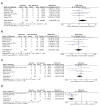Operative Versus Nonoperative Management of High-Grade Acromioclavicular Injuries: A Systematic Review and Meta-Analysis
- PMID: 39898132
- PMCID: PMC11785354
- DOI: 10.7759/cureus.76682
Operative Versus Nonoperative Management of High-Grade Acromioclavicular Injuries: A Systematic Review and Meta-Analysis
Abstract
This meta-analysis investigated differences between operative and nonoperative management for functional, as well as radiological, outcomes in Rockwood III-V acromioclavicular (AC) injuries. A literature search of several databases was conducted including Elsevier, Cumulative Index of Nursing and Allied Health Literature (CINAHL), PubMed, Cochrane Database of Systematic Reviews, Cochrane Central Register of Controlled Trials, Scopus, and Web of Science from inception to May 28, 2024. Included studies reported patients older than 16 years with a diagnosis of AC joint (ACJ) injury of Rockwood grade III or higher. This review was registered in PROSPERO (ID: CRD42023431602). Thirteen studies met the eligibility criteria (n = 729) of patients receiving either operative or nonoperative treatment for acute AC injuries. At 24-48 months follow-up, constant score outcomes favored the operative group compared to the nonoperative group (MD = 2.38, 95% CI: 0.14, 4.62; I2 = 66%). Radiological outcomes were in favor of the operative group such that the ACJ width was narrower (MD = -5.60, 95% CI: -6.67, -4.54; I2 = 11%), and the incidence of ACJ dislocations/subluxation was less compared to the nonoperative group (OR = 0.01, 95% CI: 0.00, 0.07; I2 = 0%). More patients in the nonoperative group had "good" subjective evaluation of results compared to the operative group (OR = 0.55, 95% CI: 0.33, 0.90; I2 = 80%). There were 54 (18.3%) complications in the operative group. On the other hand, there were 39 (15.9%) adverse events in the nonoperative group. Operative management of Rockwood III-V AC injuries appears to confer greater functional and radiological patient outcomes. Further long-term research is required to elucidate whether this remains longitudinally, with specific investigation for individual Rockwood grading.
Keywords: acromioclavicular joint injury; meta-analysis; nonoperative; operative; rockwood classification iii-v.
Copyright © 2024, Adra et al.
Conflict of interest statement
Conflicts of interest: In compliance with the ICMJE uniform disclosure form, all authors declare the following: Payment/services info: All authors have declared that no financial support was received from any organization for the submitted work. Financial relationships: All authors have declared that they have no financial relationships at present or within the previous three years with any organizations that might have an interest in the submitted work. Other relationships: All authors have declared that there are no other relationships or activities that could appear to have influenced the submitted work.
Figures






References
-
- Imaging of the acromioclavicular joint: anatomy, function, pathologic features, and treatment. Flores DV, Goes PK, Gómez CM, Umpire DF, Pathria MN. Radiographics. 2020;40:1355–1382. - PubMed
-
- Evaluation and treatment of acromioclavicular joint injuries. Mazzocca AD, Arciero RA, Bicos J. Am J Sports Med. 2007;35:316–329. - PubMed
-
- Acromioclavicular joint injuries: indications for treatment and treatment options. Johansen JA, Grutter PW, McFarland EG, Petersen SA. J Shoulder Elbow Surg. 2011;20:0–82. - PubMed
-
- Rockwood CA, Green DP. Philadelphia: Lippincott; 1984. Fractures in Adults.
Publication types
LinkOut - more resources
Full Text Sources
Miscellaneous
